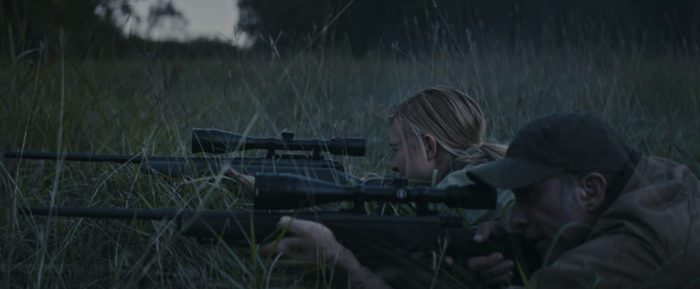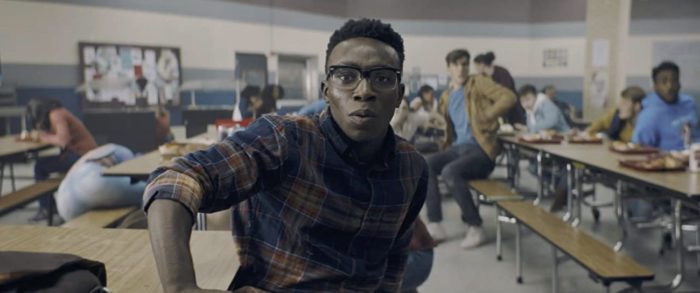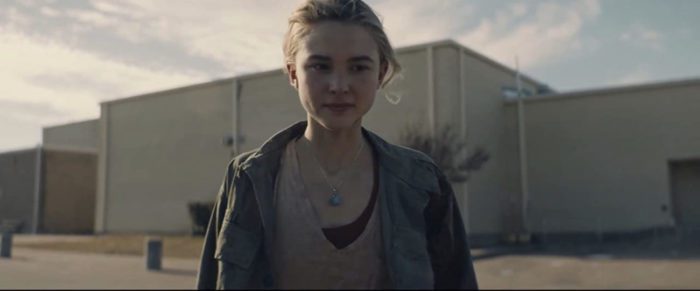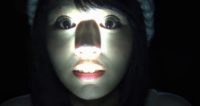It would be the acme of arrogance to imply that I’m the first to note that the plot of Kyle Rankin’s Run Hide Fight is essentially Die Hard in a high school. So, while that fact is acknowledged here, I don’t consider it an issue at hand for the purposes of this review. As a horror movie, it exists in a gray area between purist horror, thriller, or simply a straight action flick.
I’m loath to pigeonhole a film by constraints of one genre. However, and to my way of thinking, the mere fact that this film engines its plot with possibly the most uncomfortable and horrific element of modern crime serves ample fodder to give the movie some acknowledgment as horror, or perhaps, as the YouTube channel Dead Meat might put it, “horror adjacent.” Horror or otherwise may be part of the movie’s issue; it doesn’t seem to know what it is and its characters besides.

Take the antagonists, for one. The ringleader of the active killers who serve as the villains is Tristan Voy (Eli Brown). His motives are nihilistic but in a hazy sense. His confederates don’t fare much better. Rather, they come off as caricatures more than anything, and depicting them as becoming criminals due to mental issues is a contentious idea at best. Perhaps this fact is balanced out though, by Zoe (Isabel May), our hero, having her own mental issues, namely in the form of seeing her dead mother from time to time.
Zoe is probably the most well-rounded character in the film, as befits her position as a protagonist. Her character development is driven mainly through conversations with her dead mother, live father, and Olly (Lewis Washington), her friend and confidant who dreams of more between them. Right away, Zoe’s introduction exposits her as a rebel, more in a societal sense than in standard teen phases. This is most evident by her refusal to own a cellphone. The same introduction establishes also that her father (Thomas Jayne) is an army veteran (though his jacket bears no resemblance to any uniform the U.S. has ever issued), who has taught Zoe the craft of hunting and marksmanship.

Ultimately, Run, Hide, Fight does nothing new or all that unique. In a lot of ways, I feel that it plays things too safe. It takes a subject that our society is deeply uncomfortable with and forces its audience to confront it, something that great horror has done for centuries. I feel that if someone wants to tell a story about a violently taboo subject like active shooters, they need to fully embrace the most horrific aspects of such people—not for cheap shock value but to communicate the full scope of how bad such things are. This movie reduces its characters to cliches, but many stories are driven less by characters than by the responses to the situations they are thrust into. I think the value of looking at this movie, especially from a horror framework, is what it says about society and our cultural fears.
Indeed, what notoriety the film has stems from its controversy. Set it anywhere else, and it would likely fade from view posthaste. The Die Hard on an X plot variations were nearly played out before most of this movie’s actors, myself, and likely most of the people on this website were old enough to read, but Run, Hide, Fight enjoyed a flap of the free publicity controversy offers, especially for a film that is only available to stream on one service. Mass killings hold a macabre thrall over us today. In an age where all manner of gruesome criminal footage is often made publicly available, attorneys are understandably still reticent to publish evidentiary photos and film, nor do families tend to want such media in the public sphere. These restrictions, and the controversies over how best to stop such shootings, unfortunately fuel conspiracy theories.
A discussion I had on Discord led to the conclusion that Run, Hide, Fight is a filmed version of the Sheepdog Fantasy. For those unfamiliar, a Sheepdog Fantasy involves one individual assuming themselves to be a protector who will rise to the occasion and stop a mass killing or similar crime or medical emergency, with the fantasy scenario predicated on the idea that all other civilians will do little or nothing to help themselves or others, and police and medical personnel will be ineffective or not respond. I once met a man (though he was closer in age to a teenager) who claimed he shot a person dead in Dallas, oversaw the victim’s medical care, then “put [the cops] in their place” when they tried to interview him about the shooting.
I never uncovered any objective evidence that this incident actually happened, but such a claim is a hallmark of how self-proclaimed Sheepdogs characterize themselves and the scenarios they imagine to find themselves in. Every shot hits only the perpetrator, not any panicking children. The Sheepdog suffers no injuries, or at least none that are severe. As a scene in Run, Hide, Fight echoes, the hero of the fantasy does throw up, soil themselves, or suffer a mental breakdown or any of the other extremely unpleasant side effects associated with killing. In Run, Hide, Fight, it is much the same. One hero does what has to be done despite a lack of training or experience, while everyone else flounders, and, when she is finally shot, she shrugs off a wound that would have realistically resulted in amputation.

As a horror film, Run, Hide, Fight misses more than it hits, but despite a lack of the utterly cold realism that brought the terror of school killings home in films like Elephant, it hits certain horror “buttons” effectively by not pulling punches on how nasty reality can be. I would argue that no fictional media can ever hold a candle to what real humans are capable of. Regardless of the controversy of making a movie inspired by fresh tragedies, horror is ultimately inspired by real life more often than not and works best when it confronts audiences with real issues. Run, Hide, Fight may take the approach of sensationalism that Hollywood veers towards when dealing with nearly any field, but it does at least force a one on one acknowledgment of a painful aspect of modern life that even the leaders tasked with dealing with it would just as soon ignore.



